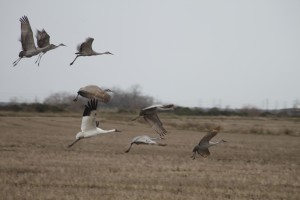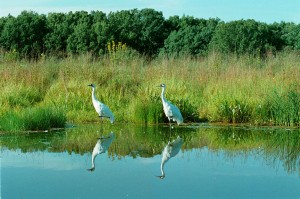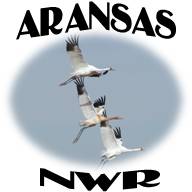Archive for April 23, 2013
Whooping cranes start journey to Wood Buffalo
April 23, 2013by Renée Francoeur
Wood Buffalo National Park’s flock of whooping cranes is headed home to the Northwest Territories.
The Whooping Crane Conservation Association (WCCA)reported last week that approximately 50 to 60 per cent of the cranes had already left their wintering grounds on the Texas coast in the Aransas National Wildlife Refuge.
On Thursday, WCCA’s Chester McConnell said he received word of the first whooping crane sighting of the year in Canada from an observer in Radisson, Sask.
“The citizen who reported (it) advised that one and one-half foot of snow was on the ground, but the whoopers were standing in a dugout,” McConnell said in an email. “Hopefully the Canadian public will be happy that their birds are coming home to nest.”
The birds undertake the 2,500 mile migration each year to nest and rear their young in Wood Buffalo.
US Whooping Crane Recovery Coordinator Wade Harrell monitors the flock in Aransas and reported to McConnell that despite some cranes still being observed on the refuge, the migration is well underway.
While the birds seem to be leaving en masse, they actually have staggered departures and leave in small groups, Harrell related.
Bird watchers can log their crane sightings at https://whoopingcrane.com/report-a-sighting/ .
To see a map illustrating the cranes’ 2013 migratory progress, visit https://whoopingcrane.com/migration/ where observations have been posted since mid March. This map cannot be used to locate the birds as all postings are delayed by at least one week to help prevent harassment of the birds.
Canada is home to the world’s largest migratory population of whooping cranes. According to Environment Canada, there are almost 300 birds in the migratory Wood Buffalo flock.
Whooping cranes were designated as endangered in Canada in the year 2000. The birds are protected by the Migratory Bird Treaty Act and the Endangered Species Act.
Whoopers Continue On Their 2,500 Mile Migration
April 16, 2013by Chester McConnell, Whooping Crane Conservation Association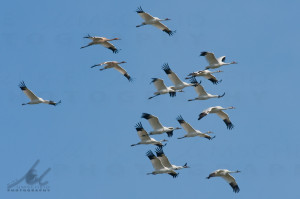
Approximately 50 to 60 percent of the whooping cranes have departed from Aransas Refuge (Texas coast) on their long 2,500 mile migration to Wood Buffalo National Park in Canada. Wood Buffalo is where they nest and rear their young. Dr. Wade Harrell, U.S. Whooping Crane Recovery Coordinator continually monitors the whooper flock on Aransas National Wildlife Refuge. Harrell described the ongoing migration of the birds as normal this spring. He explained that, “Whooping cranes are still being observed on the refuge, but the migration is well underway.
Harrell explained that, “As of Monday, April 8, 14 of the telemetry marked birds that we are actively receiving data on were still present on the Texas coast and 21 have begun migration. Based on this information and other observations, it is likely that greater than 50% of the birds in the Aransas/Wood Buffalo flock are currently migrating north. Of the 21 marked whooping cranes currently in migration, 14 are as far north as Nebraska and the Dakotas.”
Harrell estimates that most remaining birds will depart from Aransas Refuge over the next couple weeks. He advised that, “Whoopers are scattered along the migratory path as far north as North Dakota. Though the birds seem to be leaving in mass, they actually have staggered departures and leave in small groups. This is important as it ensures survival of the species. If they were to all leave together and encountered bad weather or some other catastrophic event, it could put the whole flock in jeopardy.” Dr. Harrell’s migration information mirrors information collected by the Whooping Crane Conservation Association (WCCA). Many bird watchers and a variety of citizens observe whooping cranes and report then on WCCA’s web page https://whoopingcrane.com/ .
Anyone who spots a whooper can go the web page and click on Report a Sighting and complete a simple form. WCCA places the information received on a map during the spring and fall migrations. Anyone can keep up with the migration by clicking on https://whoopingcrane.com/migration/ .
Migration Map
WCCA’s Migration Map includes all creditable whooping crane observations from reports received. Each whooper “icon” on the map represents from 1 to 6 birds. Observations have been posted on the Spring Migration 2013 map since mid-March. Importantly, all postings are delayed at least one week to help prevent harassment of the birds. Because the whoopers move frequently during migration, it is highly unlikely that one can use the map to locate the birds.
Water for Wildlife: The Fate of the Whooping Crane Depends on It
April 13, 2013by Melinda Taylor, University of Texas School of Law*
Texas is entering the third year of a drought that threatens to be worse than the 1950s’ drought of record. Across the state, the reservoirs that supply our towns and support industrial and agricultural demands are at alarmingly low levels, with no relief in sight.
The Texas Legislature is poised to create a fund to help finance conservation measures and new water infrastructure, an important step toward implementing the state’s water plan and ensuring that the water needs of the state’s growing population are met. The fund is the Legislature’s response to the economic impacts of the current water shortages: impacts on agriculture, recreation, and business.
But the drought has exacted a toll on the natural environment, too, causing harm to native and wildlife that is difficult to quantify. The shortage of rainfall has caused disruptions in the normal food chain, affecting everything from bats and birds to squirrels, raccoons, and white-tailed deer.
For the most part, impacts to wildlife take a back seat in the public’s mind to the ramifications for humans if the drought persists. But the interests of humans and wildlife often intersect and can sometimes collide, a point brought home by a federal court’s March 11 order to the Texas Commission on Environmental Quality to stop issuing water permits in the Guadalupe River in order to protect an endangered species on the Texas coast, the Whooping Crane.
On its face, the lawsuit appears to be yet another clash of endangered species versus humans, a Texas version of the spotted owl debate of the 1990s, or perhaps the latest example of federal impingement on Texas’s power to regulate its own natural resources. But, not surprisingly, the truth is more complicated. The reality is that the lawsuit was a last ditch effort to ensure that the Whooping Crane and the beautiful, resilient, finely tuned coastal ecosystem on which it depends can survive over the long run, even as the state grapples with the difficulty of meeting humans’ water needs during times of drought. The remedy ordered by the judge – that the state stop issuing permits to water users until it formulates a plan to protect the bird – is a common sense approach that should lead to a balanced state water permitting program.
The Whooping Crane is a majestic creature, the tallest crane species in North America and the rarest crane in the world. It is also an Endangered Species Act success story. In the 1940s there were fewer than 15 individual Whooping Cranes left in the world. Today, the population is estimated to be more than 500, with the world’s only self-sustaining wild population wintering in south Texas in and around Aransas National Wildlife Refuge. The Whooping Crane feeds on wolf berries and blue crabs, both of which suffer when San Antonio Bay becomes too salty, the result of inadequate freshwater flows into the bay. In 2009, scientists from the U.S. Fish and Wildlife Service, which manages the Refuge, noticed that Whooping Cranes were dying and appeared to be malnourished. They concluded that the birds’ food sources were literally drying up and that the only way to ensure their long term survival was to get more fresh water into the bay.
The Aransas Project, or “TAP,” was formed by conservationists, business owners, and landowners concerned about the Whooping Crane and determined to convince TCEQ to allow more water to flow down the Guadalupe River and reach the bay. They applied for a water permit with the intention of keeping the water they were allocated in the river, rather than pumping or diverting it, but the agency rejected the application. As a last resort, they brought suit under the federal Endangered Species Act, alleging that TCEQ was causing harm to the Whooping Crane by failing to ensure that sufficient freshwater reached the coast to maintain the crane’s food supply.
In December 2011, there was an 8-day trial during which the judge heard evidence from all the parties about all aspects of the case, including the Whooping Crane’s food requirements, the number of birds that live in Texas, and the State’s water permitting program and its ability to manage flows in the Guadalupe. The State and intervenors Guadalupe-Blanco River Authority and the San Antonio River Authority argued that a state law passed in 2009 set up a process by which the state would determine what flows are necessary to protect the state’s rivers, which precluded the need for federal action. But the court found a gaping hole in the state’s position: the state program on its face does not apply to existing water permits, only to new permits. Because the vast majority of water in Texas rivers and streams has been appropriated to water users already, it would be difficult, if not impossible, to secure sufficient flows to protect the Whooping Crane by relying solely on permit conditions in future permits. The court ruled in favor of the plaintiffs in the case and ordered TCEQ to devise a plan to protect the crane.
The Endangered Species Act contains a provision called an incidental take permit that authorizes otherwise lawful activities that cause harm to endangered species. To obtain a permit, a person (or state agency, as in this case) must prepare a “habitat conservation plan” to demonstrate that harm to the species will be minimized and mitigated “to the maximum extent practicable.” In this case, the U.S. Fish and Wildlife Service has pledged to work with TCEQ to develop a plan to protect the Whooping Crane and its habitat in the course of administering the state’s water permitting program. The habitat conservation plan will fill the hole in the state’s program and provide an important safety net for the crane. Rather than resisting all federal involvement, TCEQ should cooperate with the Fish and Wildlife Service and figure out a creative way to ensure the long-term survival of this glorious denizen of the Texas coast.
* Senior Lecturer and Executive Director, Center for Global Energy, International Arbitration and Environmental Law, University of Texas School of Law
Whooping Crane Update – Aransas National Wildlife Refuge (summary)
April 12, 2013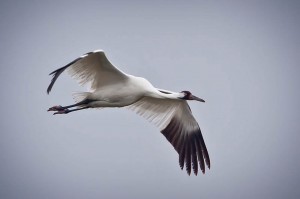 by Wade Harrell, U.S. Whooping Crane Recovery Coordinator
by Wade Harrell, U.S. Whooping Crane Recovery Coordinator
Whooping Cranes on the Refuge:
Birds are still being seen on the refuge, but the whooping crane migration is well underway and we expect that most birds will depart the coast over the next couple weeks. Based on the tracking data and incidental observations, it appears that the birds using the periphery areas of the winter range (i.e. Lamar, Granger Lake, El Campo, Welder Flats) have been the first to depart this year. Though the birds seem to be leaving in mass, they actually have staggered departures and leave in small groups. This is important as it ensures survival of the species. If they were to all leave together and encountered bad weather or some other catastrophic event, it could put the whole flock in jeopardy.
Tracking Efforts:
As of Monday, April 8, 14 of the marked birds that we are actively receiving data on were still present on the coast and 21 have begun migration. Based on this information and other observations, it is likely that greater than 50% of the birds in the Aransas/Wood Buffalo flock are currently migrating north. Of the 21 marked whooping cranes currently in migration, 14 are as far north as Nebraska and the Dakotas
Taking a look into the past as we consider the future:
The following graphic shows the expansion of wintering whooping cranes on and around the Refuge over the past 55 years (1951-2006). As we have seen this winter, this expansion has now moved to a few inland locations such as the Granger lake area. This trend gives us hope that the species will continue on the upward trend. To read the full report, click on: http://www.fws.gov/nwrs/threecolumn.aspx?id=2147517593
Water, Whooping Cranes, and the ESA
April 5, 2013by Dave Owen, Associate Professor of Law, University of Maine School of Law*
Three weeks ago, a federal district court in Texas issued an important ESA decision. The Aransas Project v. Shaw also is a very long decision—124 pages, to be exact—so I’ve been a bit slow to get a blog post up. Despite its daunting length, the case is important reading for anyone interested in water management or the ESA. It’s also a rather intriguing case study of the use—both successful and badly botched—of expert testimony in environmental litigation.
 The case arises out of water management controversies in Texas. According to the plaintiffs, the Texas Commission on Environmental Quality and its fellow defendants had taken whooping cranes in violation of section 9 of the Endangered Species Act. They had done this, the plaintiffs argued, by allowing excessive water withdrawals from the river systems that feed into the Aransas National Wildlife Refuge, which provides vital whooping crane habitat. The court agreed, enjoined the issuance of new water permits, and ordered the defendants to prepare a habitat conservation plan and seek an incidental take permit.
The case arises out of water management controversies in Texas. According to the plaintiffs, the Texas Commission on Environmental Quality and its fellow defendants had taken whooping cranes in violation of section 9 of the Endangered Species Act. They had done this, the plaintiffs argued, by allowing excessive water withdrawals from the river systems that feed into the Aransas National Wildlife Refuge, which provides vital whooping crane habitat. The court agreed, enjoined the issuance of new water permits, and ordered the defendants to prepare a habitat conservation plan and seek an incidental take permit.
That’s a very interesting outcome, because successful section 9 actions against water managers don’t seem to be particularly common. I haven’t done any sort of rigorous survey, but my impression, based on working as a water lawyer and then on my academic research into related ESA questions, is that environmental groups have gained much more leverage through ESA section 7. Indeed, in the Southeast’s longstanding Apalachicola-Chattahoochee-Flint controversy, similar take claims brought against upstream water managers failed. See Alabama v. Army Corps of Engineers, 441 F. Supp. 2d 1123 (N.D. Ala. 2006) . So could this case signal the emergence of a new front in the ESA/water allocation wars? My suspicion is that several factors will make these plaintiffs’ success difficult to replicate. In no particular order, those factors are:
The extraordinary level of data available to the plaintiffs in this case. Reading the opinion made me wonder if these whooping cranes are one of the most carefully observed wild animal populations on earth. As the court describes, scientists have been counting whooping cranes since the 1950s. Since the early 1980s, scientists—including one of the plaintiffs’ experts—have conducted dozens of monitoring flights every year. The resulting level of information is exceptional. Usually population biologists must rely on some combination of observational data (usually limited), proxy indicators like habitat conditions, and computer-based modeling to assess the status of a population. The resulting uncertainties can limit plaintiffs’ ability to demonstrate causal relationships with enough certainty to support a successful ESA section 9 claim. With whooping cranes, the circumstances are quite different.
The imbalance of experts. The plaintiffs had an impressive array of experts on their side. Here’s the court’s description:
At trial, TAP presented seventeen witnesses, ten of whom were experts, GBRA eight; SARA one: and TCEQ two. As will be discussed in more detail later, TAP’s experts were world renowned in their respective fields. Several of TAP’s witnesses hold endowed chairs at prestigious universities, some are MacArthur Fellows, all have published numerous scientific papers in respected journals. Indeed, one witness, Dr. Ronald Sass, is a shared recipient of the 2007 Nobel Peace Prize for his environmental work. TAP’s crane experts… have years of study in the field and have devoted their time and energies to the survival of the AWB species. All of TAP’s experts were accepted as such and the Court finds their testimonies compelling and credible.
The court had less laudatory things to say about the defendants’ experts. For example:
Dr. Slack did not personally spend any significant amount of time in the field, averaging one day per year over the past fifteen years. Contrary to the scientific literature, Dr. Slack testified that cranes did not need freshwater because they had functioning supraorbital salt glands which allowed them to secrete excess salt. However, when questioned further by the Court, Dr. Slack admitted that he had no observational basis for this statement, he had not reviewed literature on cranes and freshwater, and that he “just made it up.” (record citations omitted)
The level of judicial interest. From the outset, the narrative structure of the opinion (yes, it does have a narrative structure) strongly suggests that someone in the court’s chambers cared very deeply about this case, and probably also about whooping cranes. Before getting into the procedural history, relevant law, or even the identities of the parties, the opinion spends several pages describing the whooping crane die-off, much like a detective novel beginning with the key murder. But the real tip-off comes later, in a remarkable passage debunking the work of one of the aforementioned Dr. Slack’s graduate students:
[A key defense report] used a report by Dr. Slack’s graduate student Danielle Greer whose conclusions to the preferred food of whooping cranes was (sic) based on 90 plus hours of video of three crane areas. The Court watched all of the videos and finds that they were either too blurred to see anything or non-demonstrative of any habit, feeding or otherwise.
So what does this all suggest? If I’m reading correctly, it shows that when plaintiffs have extraordinarily good monitoring data, an all-star team of experts, poorly prepared experts on the other side, and a judicial chambers where someone—perhaps the judge, more likely a clerk—cares so deeply that she is willing to watch 90 hours of blurry footage of whooping cranes, they can win an ESA section 9 case against upstream water managers. Absent those circumstances, the challenge might be a bit harder. That doesn’t mean there won’t be other cases like this. Conflicts between water withdrawals and the needs of endangered fish and wildlife probably aren’t going away any time soon. But the case does illustrate the level of scientific and legal work necessary for plaintiffs to prevail.
* Dave Owen’s article is re-posted from Environmental Law Prof Blog, A Member of the Law Professor Blogs Network
Newsletter – Spring 2013
April 4, 2013MY SOAPBOX
April 1, 2013Editor Note: This exceptional article by Joe Duff is posted with permission of Operation Migration. Joe has a way with words as well as flying ultralight planes to lead young whooping cranes on their first migrations. The article is a lesson that should be read by all who venture onto wild lands and encounter wildlife. Please read and pass it on. Thanks Joe and O.M.
by Joe Duff, Operation Migration, Mar. 27, 2013
Earlier this month Fox 13 News in Tampa Bay posted an article about two photographers who overstepped the line of ethical wildlife observation by handling a two week-old Sandhill crane chick. They were captured on film and now wildlife officials say they could face charges if they can be found.
People do a lot worse to animals than handling their offspring, and although it is not condoned, that’s not the interesting part of this story. What is more telling is the mixed reactions posted in the comments section. Some people feel the perpetrators should be shot for their transgressions while others think they had every right to play with a baby bird.
The most common reaction is that maybe they didn’t know they were not allowed to handle wildlife. That excuse was also suggested when Whooping cranes were shot by kids showing off to their girlfriends. Many people commented that if the shooters had known what they were, or if more education was available, those birds wouldn’t have been shot — with a high powered rifle — on private property — at night. If that was a valid defence you could simply say, “Sorry I burned your house down. I didn’t know I wasn’t allowed to”. Ignorance of the law is not a defence, it is simply ignorance – not only of the rules but also of our responsibility to nature.
The fact that we even need laws at all is evidence of how we view our relationship with the environment. If we truly appreciated the connection between nature and ourselves, rules to protect it would be as unnecessary as a law against destroying our own wealth.
The planet, in all its complexity is the producer of everything we have, the materials we use to build our society, the water we drink, even the air we breathe. There is no other source for those essentials yet we use them as if they were inexhaustible. We are the prodigal heirs of a rich family. We did nothing to create the prosperity and we lack the ability, or the motivation, to maintain our inheritance, yet we spend the wealth with no concern for the future. But the environment was not inherited from our grandparents, More accurately it is borrowed from our grandchildren.
So what does it matter that a photographer in Florida handled a Sandhill chick to get a better picture when cranes are hunted in some states? It matters because it demonstrates how little we care about the creatures around us. Through his willingness to ignore the rules, he chose his own gratification over the welfare of the chick. Whether it was a desire for a better photograph or simple curiosity, he threatened the life of that bird for his own benefit. His ignorance of the consequences is as inexcusable as his ignorance of the law.
For those who think no harm was done, you don’t understand the stress load on the parent. A crane may abandon their chicks if the threat is too great. Instinct tells them it is better to escape and reproduce again next season than to be injured defending a chick that will perish as a result. If the chick is lost, the adult will survive, but if the adult is injured, they will both die.
As for the chick, they are vulnerable at that age. They hatch neither tame nor wild but have a natural fear of the unfamiliar. Most of their wildness is learned from the parent. An adult bird will remain wary despite several encounters with people, but a chick can become complacent after only one. Despite our good intentions, tame birds have a far shorter life span that their wild counterparts.
The point is, that all creatures are part of the ecosystems that make the world work. Damaging them even slightly, can have long term consequences that at some point will affect our lives. If we want to protect our future, we must learn to respect nature, even the baby Sandhills.
Bob Hunter, one of the founders of Green Peace, once said, “Conservationists are a pain in the ass, but they make great ancestors.”
http://operationmigration.org/InTheField/2013/03/27/my-soapbox/

